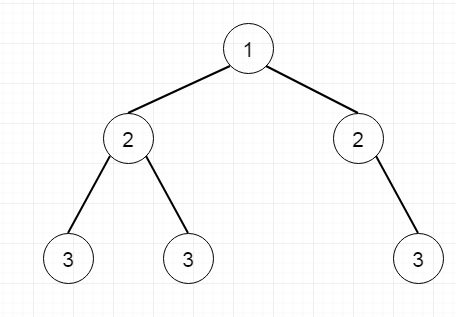
 Data Structure
Data Structure Networking
Networking RDBMS
RDBMS Operating System
Operating System Java
Java MS Excel
MS Excel iOS
iOS HTML
HTML CSS
CSS Android
Android Python
Python C Programming
C Programming C++
C++ C#
C# MongoDB
MongoDB MySQL
MySQL Javascript
Javascript PHP
PHP
- Selected Reading
- UPSC IAS Exams Notes
- Developer's Best Practices
- Questions and Answers
- Effective Resume Writing
- HR Interview Questions
- Computer Glossary
- Who is Who
Maximum Depth of Binary Tree in Python
Suppose we have one binary tree. We have to find the maximum depth of that tree. The maximum depth of a tree is the maximum number of nodes that are traversed to reach the leaf from the root using the longest path. Suppose the tree is like below. The depth will be 3 here.

To solve this, we will follow these steps.
- Here we will use the recursive approach. The method is solve(root, depth = 0)
- if the root is empty, then return depth
- otherwise return max of solve(left, depth + 1) and solve(left, depth + 1)
Let us see the following implementation to get a better understanding −
Example
class TreeNode: def __init__(self, data, left = None, right = None): self.data = data self.left = left self.right = right def insert(temp,data): que = [] que.append(temp) while (len(que)): temp = que[0] que.pop(0) if (not temp.left): if data is not None: temp.left = TreeNode(data) else: temp.left = TreeNode(0) break else: que.append(temp.left) if (not temp.right): if data is not None: temp.right = TreeNode(data) else: temp.right = TreeNode(0) break else: que.append(temp.right) def make_tree(elements): Tree = TreeNode(elements[0]) for element in elements[1:]: insert(Tree, element) return Tree class Solution(object): def maxDepth(self, root): """ :type root: TreeNode :rtype: int """ return self.solve(root) def solve(self,root,depth = 0): if root == None: return depth return max(self.solve(root.left,depth+1),self.solve(root.right,depth+1)) tree1 = make_tree([1,2,2,3,4,None,3]) ob1 = Solution() print(ob1.maxDepth(tree1))
Input
tree1 = make_tree([1,2,2,3,4,None,3])
Output
3

Advertisements
